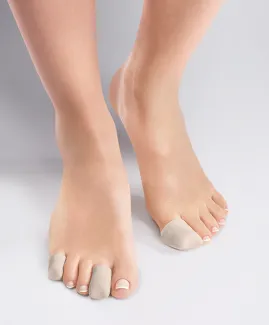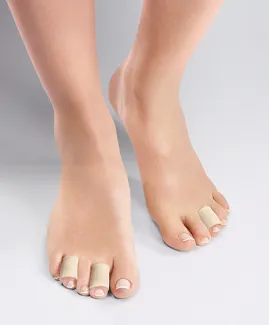
Foot corns are common skin lesions. These unsightly deformities are the result of a protective reaction against skin damages. To fight against repeated pressures and frictions, the skin thickens until a shield of horn forms. This is called hyperkeratosis. But are we all equal regarding this process? Do some people develop foot corns more easily? Who is concerned by this condition?
EPITACT®, the podiatry care specialist, reveals what are the aggravating factors of foot corns.
Some figures about foot corns
A study(1) reported that between 16 and 48% of people suffer from foot corns. This foot deformity also seems to affect women more than men.
This phenomenon is mainly due to the wearing of high heels and narrow-toed shoes. Indeed, the daily stresses on the feet would deform them. In addition, we know that regular rubbing and pressures on one area are responsible for corns and calluses.
Risk factors for foot corns
Some factors seem to favour the development of foot corns. Actually, inappropriate shoes are often pointed out: bulky seams, frictions, pressures due to narrow-toed shoes are all stresses that push your skin to protect itself!
Also, anatomical factors can play a role. Therefore, feet that present one or more deformities (hallux valgus, claw toe, hammer toe...) would be associated with the development of corns. The study(2) carried out by Takeshi Mochizuki et al. in March 2020 on over 200 patients shows this link between conditions. It also demonstrates that an early care of these deformities would limit the development of callosities.
Because age often leads to a deterioration of skin elasticity(3), it is also a risk factor which may favour the formation of foot corns.
Of course, excessive use of the feet or repeated stresses are aggravating factors. It is especially the case of many professions implying prolonged standing position. For example, we can cite catering, logistics or handling jobs. In these cases, wearing silicone and thin protections is particularly recommended. This interface limits pressures and rubbing between the shoe and the foot.
A trauma can also lead to gait modification, transfer of the body weight and finally cause pressures and callosities.
Effective treatments for foot corns
Don’t worry, foot corns are far from being a fatality. Once the causes are identified, your chiropodist will be able to remove the dead skin. Applying a cream dedicated to dry feet moisturises the upper layers of the skin to find soft feet again!
Lastly, protect the areas from frictions with the DIGITUBES®* for your toes and with the Digitops* in the case of distal corns. For hammer toes, opt for the hammer toe cushions*. You will be comfortable again in your shoes!
*These solutions are class I medical devices that bear the CE marking under this regulation. Carefully read the instructions before use. Manufacturer: Millet Innovation. 09/2021
For more details about this general and simplified approach, here are further sources:
(1)Farndon L, Concannon M, Stephenson J. A survey to investigate the association of pain, foot disability and quality of life with corns. J Foot Ankle Res. 8 déc 2015;8:70.
(2)Relationship of callosities of the forefoot with foot deformity, Health Assessment Questionnaire Disability Index, and joint damage score in patients with rheumatoid arthritis. Mochizuki T, Yano K, Ikari K, Hiroshima R, Ishibashi M, Okazaki K.Mod Rheumatol. 2020 Mar;30(2):287-292. doi: 10.1080, p 14397595.2019-1589921. Epub 2019 Apr 1.PMID: 05/3083602805/35
 Pharmacie
Pharmacie

